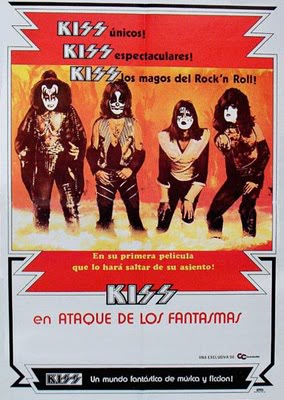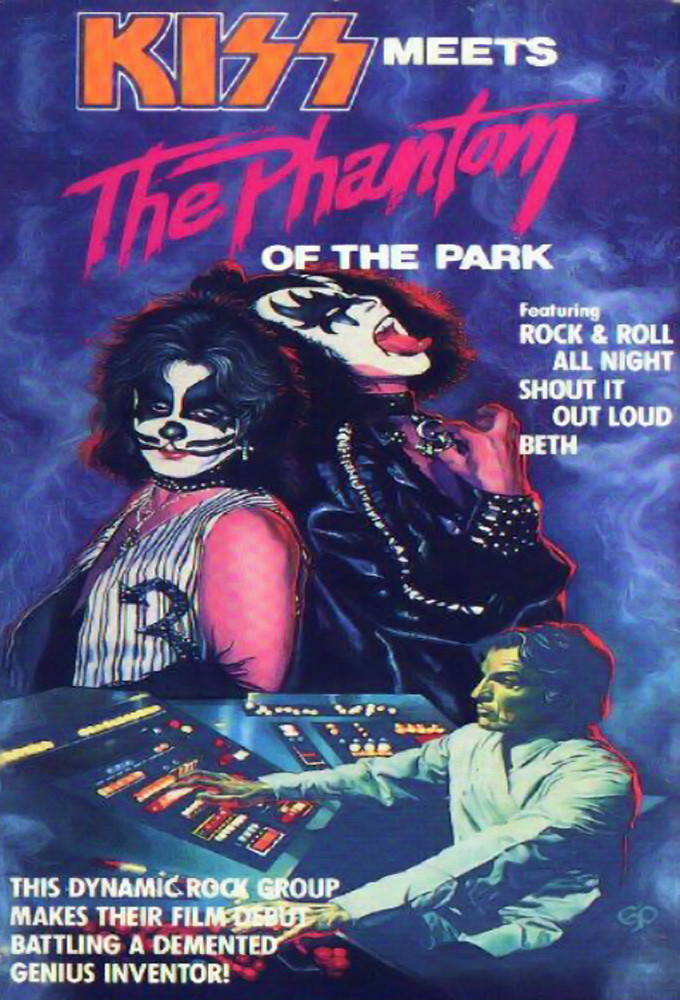Even though I already posted this week’s edition of Rejected By Rod(?), I’m dipping back into my well of unposted Flick Attack reviews to start off this look at a B-TV classic. The FA part of this review was actually included in the first batch I ever sent to Rod, when I very briefly held myself to a very strict 250-word limit, which explains why it’s so much more pithy and succinct than my typical FA output.
Kiss Meets The Phantom of The Park
(1978)
The defining moment of the 1978 TV movie Kiss Meets the Phantom of the Park comes when drummer Peter Criss (aka Cat Man) first speaks aloud and the familiar Saturday morning cartoon voice of male Wonder Twin Zan (Michael Bell) comes out of his mouth. It’s then that you realize this film was: A) produced by Hanna-Barbara, B) stars a bunch of people who REALLY didn’t want to be involved in its production and C) is far more wonderful than mere mortals like us probably deserve.
Starring the world’s greatest all-time terrible rock band, the original members of Kiss play themselves—with the fictional license that along with being unapologetic cash whores, they also each possess super powers, which they’ll need in order to stop the titular villain (a slumming Anthony Zerbe) who is turning amusement park customers into robotic slaves. The band is alerted to his evil doings by a pretty young fan named Melissa, (Deborah Ryan) who—in the film’s most fantastic and unrealistic contrivance—Gene Simmons doesn’t try to fuck.
Normally talented genre director Gordon Hessler (The Golden Voyage of Sinbad), couldn’t overcome the film’s non-existent budget and as a result the film has an almost Ed Woodian level of unintentionally amusing shoddiness (ie. Ace Frehley’s stunt double is clearly an overweight black man). Definitely not for the serious minded, Kiss Meets the Phantom of the Park is one of those nostalgia pieces whose glaring imperfections actually makes it far more loveable than a well-made film.
I based the above review on multiple viewings of a really shitty bootleg copy I downloaded from Napster back when that was totally a thing you could do. As crappy as the quality was, the film itself was the same version I had seen several times play on weekday television when I was kid. So, you can imagine my surprise when I recently downloaded what I thought was merely a superior quality version of the exact same film, only to be stunned by the strange new movie that played before my eyes. Not only did it look 1000x better than my previous version, but right from the start I could tell that the editing was different, the soundtrack was better, and much of the overall suckiness had been removed.
 Being the asshole film geek that I am, I didn’t even have to turn to the Internet to figure out what was happening. All I had to do was look through my personal poster collection and find my copy of the one sheet for Kiss en ataque de los fantamas—the Spanish language version of the film, which had actually been released theatrically in Europe. I knew that when the original TV version aired, Kiss had refused to license their songs to play during non-concert/performance scenes in the films, but had changed their mind for the European release. This clued me into what I was watching. I had just been unprepared for how radically different the two films were.
Being the asshole film geek that I am, I didn’t even have to turn to the Internet to figure out what was happening. All I had to do was look through my personal poster collection and find my copy of the one sheet for Kiss en ataque de los fantamas—the Spanish language version of the film, which had actually been released theatrically in Europe. I knew that when the original TV version aired, Kiss had refused to license their songs to play during non-concert/performance scenes in the films, but had changed their mind for the European release. This clued me into what I was watching. I had just been unprepared for how radically different the two films were.
That’s not to say that this version (which is credited as Kiss in Attack of the Phantoms) isn’t as hilariously and rapturously cheesy as the version I had seen dozens of times before—it just manages to leave out all of the parts that made the original look like the Ed Wood spectacle I described in the (thus-far unpublished) FA review I originally wrote over a year ago.
I’ve always said that the best way to teach people how much impact editing can have on a project is to show them the studio and director cuts of Terry Gilliam’s Brazil, which are as radically different as two films based on the same raw material can be. The differences between Kiss Meets The Phantom of the Park and Kiss in Attack of the Phantoms aren’t that extreme, but they are significant enough to radically change the viewing experience.
The European theatrical version is close to 10 minutes shorter than the original, but by reordering and re-cutting important scenes, the plot actually feels much more organic and less haphazard—especially regarding Melissa’s search for her roboticized boyfriend. Gone are the shots featuring the overweight black stunt man dressed as Space Ace, and—most importantly—the Kiss tracks on the soundtrack bring a sense of fun and energy to the film that makes it many faults so much easier to digest. Just take a look at the difference between the classic scene where the evil robot version of Gene attacks a bunch of security guards. In the original the sequence is scored by what sounds like archival stock porn music:
While in the European theatrical cut, the same scene is scored to “Radioactive” from Simmons 1978 solo album:
In fact, the group’s (in)famous solo albums are the only sources the new soundtrack draws from—with Simmons getting the most attention. Beyond “Radioactive”, the film also uses his “Man of 1000 Faces” and “Mr. Make Believe”. Paul gets his “Love in Chains” in there, and Criss provides “Hooked on Rock ‘N’ Roll”. But the best moment belongs to Frehley, whose solo album produced the project's only lasting hit—the classic “New York Groove”, which turns the once-awful roller coaster fight sequence (see the clip embedded after the original FA review) into something pretty darn awesome:
Okay, maybe “awesome” is a bit much, but there’s no doubt that this alternative version completely changed my appreciation of this oft-mocked film. I already loved it when its imperfections couldn’t be ignored, but now that I’ve seen them successful hidden and disguised that love isn’t hipster-asshole-ironic, it’s hipster-asshole-genuine. And therein lies a whole heaping world of difference.
